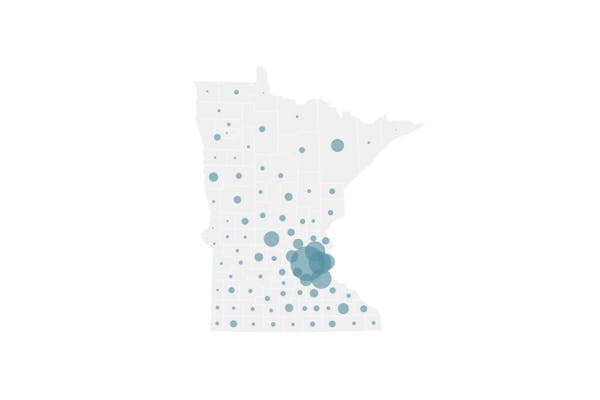Another 539 lab-confirmed COVID-19 cases brought the total so far to 18,200 in Minnesota, which is among a minority of states in which the global pandemic of the infectious disease is still peaking.
The Minnesota Department of Health on Thursday reported another 32 deaths associated with COVID-19, a respiratory disease caused by a novel coronavirus. That was a single-day high for the state and brought the death toll of the pandemic to 809. Long-term care residents made up 28 of the newly reported deaths and 663 total.
The number of Minnesotans hospitalized for COVID-19 is 566 — with 229 in intensive care, according to the department, which also reported that the growth in new hospital admissions is above a new target goal.
The rise in cases and deaths follows Monday's end of a 51-day stay-at-home order, and Gov. Tim Walz's announcement on Wednesday that he would allow restaurants and bars to offer outdoor dining as of June 1, and campgrounds to reopen.
Any increase since Monday in face-to-face contact and disease transmission in Minnesota wouldn't show up in the latest numbers, though. Symptom onset often doesn't occur until four to five days after infection. Walz said the impacts of the statewide order on the pandemic in Minnesota might not be fully seen until June 1.
Disease modeling by the University of Minnesota and state health researchers estimated that the statewide stay-at-home order reduced face-to-face contact and viral transmission by 55%. Walz said that likely explains why the course of the pandemic appears to be peaking later in Minnesota than other states.
Other states "have come through this," Walz said on Wednesday. "Our peak is still coming ... The difference between what New York had to go through and what we're going through is that we are better prepared to hit it head on."
A new Covid Exit Strategy website, produced in part by Minnesota resident and former U.S. Medicare administrator Andy Slavitt, showed that Minnesota is one of less than 20 states in which COVID-19 cases are rising. The organizers of the website penned an editorial in USA Today Wednesday calling for a careful return to normalcy and reduction in states' social distancing restrictions.
"It won't help the economy if we end up having to pull back hard or close again because the virus starts spreading toward the point where it threatens our health care systems and further disrupts our health," the authors wrote. Dave Durenberger, a former U.S. Senator for Minnesota, signed the letter.
Walz's latest order drew criticism from resort owners, who had hoped to resume activities over the pivotal Memorial Day weekend, and from the Minnesota Catholic Conference that OKed its churches to defy the order starting Tuesday and to hold masses with up to one third of their seating capacities.
Walz acknowledged the concerns and economic pains of the continued restrictions, but said the scientific information about the risk of the virus is too strong to ignore. He predicted 1,000 deaths in Minnesota by the end of May.
The state added a fifth indicator to a new "dial back dashboard" that will assess when further restrictions can be lifted. The dashboard showed a significant increase in the rate of COVID-related hospital admissions. However, COVID-19 cases are only doubling every 14 days — which is better than the state threshold of seven days.
The state continues to come closer to its ICU capacity — with 1,034 of 1,261 critical care beds occupied by patients with COVID-19 or unrelated medical conditions. The state's hospitals have another 1,124 beds that could be readied within 72 hours if needed.
New Minnesota GOP leaders seek peace with party's anti-establishment wing

Who is Republican Lisa Demuth, Minnesota's first House speaker of color?

Minnesota House GOP, Secretary of State Steve Simon return to Supreme Court
Supreme Court sides with DFL and Simon, says 68 House members needed for floor action

